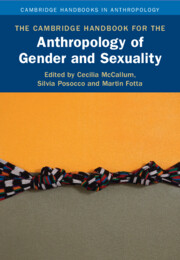Book contents
- The Cambridge Handbook for the Anthropology of Gender and Sexuality
- Cambridge Handbooks in Anthropology
- The Cambridge Handbook for the Anthropology of Gender and Sexuality
- Copyright page
- Contents
- Contributors
- 1 Introduction to The Cambridge Handbook for the Anthropology of Gender and Sexuality
- Part One Openings and Orientations
- Part Two Knowledges and Domains
- Part Three Resistances and Intersections
- 12 Social and Cultural Politics of Everyday Resistance and Empowerment
- 13 Reworking Black Feminist Anthropology through Transnational Scholar-Activism and Antiracist Solidarity in Africa and Its Diaspora
- 14 Gender in Decolonial Indigenous Perspectives
- 15 Anthropologies of Reproduction, Abortion, and Biopolitics
- 16 Gender, Capitalism, and the Erotics of Finance
- 17 Untying Poverty’s Gendered Knots Past and Present
- Part Four Desires and Relations
- Part Five Recursivities and Futures
- Name Index
- Subject Index
- References
12 - Social and Cultural Politics of Everyday Resistance and Empowerment
from Part Three - Resistances and Intersections
Published online by Cambridge University Press: 29 September 2023
- The Cambridge Handbook for the Anthropology of Gender and Sexuality
- Cambridge Handbooks in Anthropology
- The Cambridge Handbook for the Anthropology of Gender and Sexuality
- Copyright page
- Contents
- Contributors
- 1 Introduction to The Cambridge Handbook for the Anthropology of Gender and Sexuality
- Part One Openings and Orientations
- Part Two Knowledges and Domains
- Part Three Resistances and Intersections
- 12 Social and Cultural Politics of Everyday Resistance and Empowerment
- 13 Reworking Black Feminist Anthropology through Transnational Scholar-Activism and Antiracist Solidarity in Africa and Its Diaspora
- 14 Gender in Decolonial Indigenous Perspectives
- 15 Anthropologies of Reproduction, Abortion, and Biopolitics
- 16 Gender, Capitalism, and the Erotics of Finance
- 17 Untying Poverty’s Gendered Knots Past and Present
- Part Four Desires and Relations
- Part Five Recursivities and Futures
- Name Index
- Subject Index
- References
Summary
This chapter looks at the anthropological contributions to resistance as it manifests itself within people’s everyday lives. It sheds light on the multifaceted ways in which power, in the Foucauldian sense, is renegotiated in the context of everyday relationships and cultural activities. The material discussed in this chapter offers a reflection on how new forms of identities around gender and sexuality, religion, race, and ultimately agency are produced through political and cultural forms of resistance to sexism, patriarchy, Islamophobia, imperialism, and nationalism. In the first part, the chapter sets out the anthropological debates on resistance with a specific focus on Black feminist anthropology and anthropology of law and human rights. In a second part, the chapter examines different samples of feminist practice of resistance including political protest and social movements and everyday bodily performativity. The chapter concludes with a reflection on the methodological implications a feminist-queer anthropological gaze on resistance entails, stressing the need to take the voices and experiences of actors located at the margins as a starting point from where to understand the diverse, and to some extent paradoxical, forms of resistance to hegemonic forms of power.
Keywords
- Type
- Chapter
- Information
- Publisher: Cambridge University PressPrint publication year: 2023



